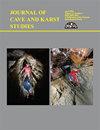The double-edged sword of ultra-high precision 40Ar/39Ar geochronology: Investigating previously unresolved complexities in sanidine age distributions
IF 0.5
4区 地球科学
Q4 GEOSCIENCES, MULTIDISCIPLINARY
引用次数: 0
Abstract
Improvement in the precision of 40 Ar/ 39 Ar sanidine geochronology has demonstrated that single crystal sanidine dates from ignimbrites are dispersed, leading to ambiguous interpretations of eruption ages. This inhibits interpretation of temporally closely spaced geologic events such as nearly coeval caldera forming eruptions, paleomagnetic reversals, extinction events, etc. Possible age dispersion sources related to (1) neutron dose differences between individual sanidine grains, (2) mineral and melt inclusion variations between grains, and (3) mass spectrometry and data reduction details have been evaluated via detailed laboratory experiments on multiple sanidine bearing ignimbrites. The accuracy of derived eruption ages is cross validated through stratigraphically constrained 27 – 28 Ma ignimbrites from the San Juan Volcanic Field that may differ in age by less than 15 ka. The 40 Ar/ 39 Ar method is based on irradiating a sample to convert 39 K to 39 Ar with the 40 Ar/ 39 Ar value being proportional to age. However, multifarious neutron flux, spatially and temporally, leads to no two grains receiving the same neutron dose, thus, variation in grain-to-grain dosage is a possible source of age dispersion. Irradiation of Fish Canyon tuff sanidine (FC-2) grains in a tightly spaced geometry significantly reduced dispersion from the typical grain-to-grain date range of up to ca. 100 ka to as low as ca. 30 ka. Although better constraining the irradiation geometry demonstrated that neutron flux variation is a large source of age dispersion, in detail, populations still show excess dispersion that likely correlates to geologic complexities. Geologic dispersion is evaluated by handpicking inclusion-free and inclusion-rich sanidine grains. Inclusion-rich grains are characterized by having visible melt and mineral inclusions when viewed under a microscope. Detailed experiments of FC-2 revealed no significant age difference or degree of dispersion超高精度40Ar/39Ar年代学的双刃剑:研究以前未解决的年龄分布的复杂性
40ar / 39ar水晶石年代学精度的提高表明,来自火成岩的单晶水晶石年代学是分散的,这导致了对火山喷发年龄的模糊解释。这阻碍了对时间间隔紧密的地质事件的解释,如几乎同时期的火山口形成喷发、古地磁反转、灭绝事件等。通过详细的实验室实验,对多种含毒烟煤进行了质谱分析和数据还原,评估了与以下因素相关的可能年龄分散源:(1)单个含毒烟煤之间的中子剂量差异,(2)颗粒之间的矿物和熔体包裹体差异,以及(3)质谱分析和数据还原细节。通过对圣胡安火山田27 ~ 28 Ma火成岩年龄差异小于15 ka的地层约束,交叉验证了推导的喷发年龄的准确性。40ar / 39ar方法是基于辐照样品将39k转换为39ar, 40ar / 39ar值与年龄成正比。然而,由于中子通量在空间和时间上的差异,导致没有两个晶粒接收到相同的中子剂量,因此,粒间剂量的变化可能是年龄弥散的来源。鱼谷凝灰岩-2颗粒在紧密间隔的几何结构中的辐照显著降低了典型颗粒到颗粒的色散,从大约100 ka到低至大约30 ka。尽管更好地约束辐照几何表明中子通量变化是年龄色散的一个重要来源,但在细节上,种群仍然显示出可能与地质复杂性相关的过量色散。通过手工挑选无包裹体和富包裹体的砂岩颗粒来评价地质弥散性。富包裹体颗粒的特征是在显微镜下观察时具有可见的熔体和矿物包裹体。FC-2的详细实验显示,年龄和分散程度没有显著差异
本文章由计算机程序翻译,如有差异,请以英文原文为准。
求助全文
约1分钟内获得全文
求助全文
来源期刊

Journal of Cave and Karst Studies
地学-地球科学综合
CiteScore
1.90
自引率
0.00%
发文量
6
审稿时长
>12 weeks
期刊介绍:
The Journal of Cave and Karst Studies is a multidisciplinary journal devoted to cave and karst research. The Journal is seeking original, unpublished manuscripts concerning the scientific study of caves or other karst features. Authors do not need to be members of the National Speleological Society, but preference is given to manuscripts of importance to North American speleology.
 求助内容:
求助内容: 应助结果提醒方式:
应助结果提醒方式:


